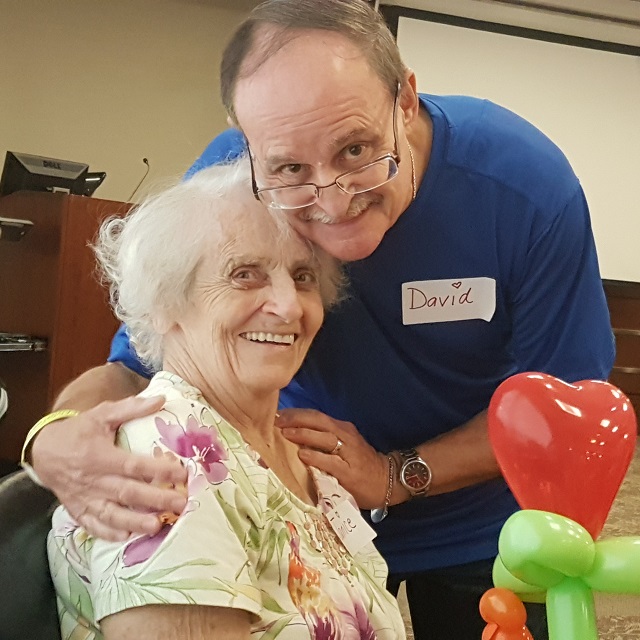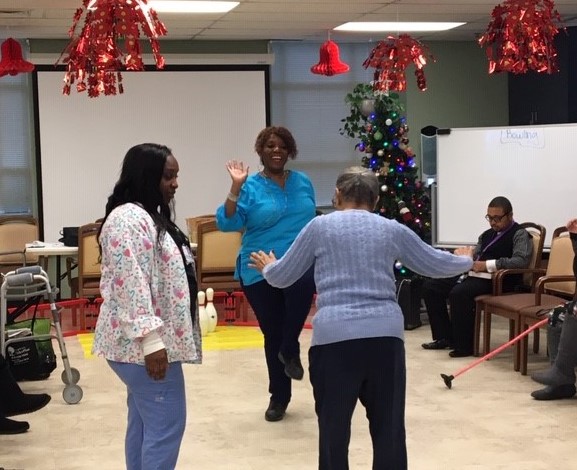As Florence Gundlach’s dementia progressed, she needed the help of her sons to eat and get out of bed. In September 2019, her family doctor recommended that her sons contact Johns Hopkins Home-based Medicine (JHOME) for support. Through JHOME, physicians and other health care professionals treat patients where they live, so that restricted mobility does not disrupt access to medical care.
“There was a time that we weren’t sure we could continue to care for her ourselves,” Rob Gundlach says regarding his mother. “JHOME has given us the tools we need. We can keep her at home. With their help, we have more confidence and assurances that we can handle the job.”
Florence, now 97, needs continuous care. Using JHOME’s recommendations, her sons remodeled her home so the bathroom, kitchen and bedroom are all on the same level. They also installed a motion detector so they will know if Florence gets up on her own.
“Through JHOME, we got her a hospital bed. Now we can walk her from there to her kitchen or the bathroom,” says Rob Gundlach. “They advised us to get foam mats for the floor so if she did fall, she wouldn’t hurt herself. Nurses came and helped train us on how to care for her. They also taught us to use a gait belt around her waist to help us guide her around the house.”
Rob Gundlach says the best thing about JHOME is the easy access to health care services.
“The doctors come to us,” he says. “They have helped us get her medicines in order. They understand the aging process and give us an idea of what’s normal. They seem to have the perfect personalities to deal with situations you can’t control. It’s a wonderful fit for us.”
Johns Hopkins Bayview Medical Center has had a house call program since the 1970s, but it was expanded and re-branded as JHOME when medical director Mattan Schuchman, M.D., came on board in 2016. The program provides long-term primary care to patients who cannot get into a clinic because of their chronic health conditions. Schuchman says the average age of JHOME’s patients is about 80, and many have conditions such as heart failure, dementia and chronic obstructive pulmonary disease.
“These are people who otherwise won’t have access to care,” Schuchman says. “There’s no way for them to get help because they can’t leave. We fill that gap. This is important because the only other way they can get seen is by calling 911. They don’t want to go into the hospital if they don’t have to.”
JHOME also connects patients to resources like mobility services, health care supplies and help with insurance navigation. By working with partners such as Medicare Advantage Plans, Schuchman says JHOME saves money for the health care system and patients because patients don’t need to visit the emergency department.
“We have really made an impact on the health system,” he says.
JHOME clinical nurse Mae Koontz says becoming a JHOME patient is sometimes a difficult transition.
“It’s quite challenging because our patients are faced with giving up some independence,” Koontz says. “They are entering another stage of life that they don’t want to enter, and they’re often frustrated. Resources can be costly, and they aren’t sure how to go about accessing resources without some direction. Many of them would be on a merry-go-round from hospital to rehab to home. JHOME gives them more choice in their care.”
One way Koontz tries to smooth the transition is by listening closely to patients’ needs.
“I ask them what their goal for today is and what would be most helpful for them,” she says. “They need someone in the moment. I try to connect with them and reassure them that they’re in excellent hands. I always remind them of how soon we’ll see them next.”
Rob Gundlach says JHOME nurses have recommended tools to encourage his mother to interact.
“They suggested giving her stuffed animals to get her to talk,” he says. “Now we have Linda the Lamb, Sammy the Sloth and Annie the Alpaca. So when she gets upset and starts to cry, she can talk to the animals.”
When Erin Hudson began working at JHOME, she shadowed a nurse for a new patient assessment and family coaching for dementia care. Hudson, who is now JHOME’s clinic program coordinator, medical assistant and community health worker, says the patient’s two sons who cared for her had given her a digital photo frame that provided a slideshow of her life. When her oldest son’s baby picture appeared, she couldn’t recognize him despite the photo caption.
“My son was about a year and a half old at the time, and I can recall feeling saddened by the thought of not being able to remember him,” says Hudson. “It was absolutely heartbreaking, and I was tearful on the ride back to our office. It was my first opportunity to witness this devastating disease and see firsthand what our caregivers and families experience. I knew then and there that I was going to be doing truly meaningful work, and I felt a sense of pride in being able to care for them.”
Hudson says some patients have excellent caregivers, such as their children or their spouse. For those families, JHOME plays more of a supportive role. Other patients have low incomes and low health literacy, and they often end up in life-threatening situations.
“A lot of these folks are completely isolated,” Hudson says. “JHOME is a lifeline for them. We help patients stay out of emergency rooms and have more say in what the outcome of their life is.”



